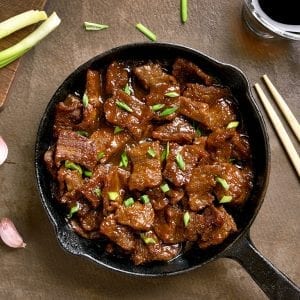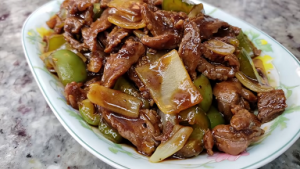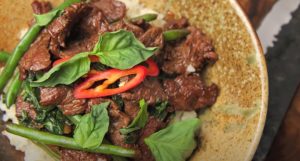Mongolian Beef is a dish that brings together the rich flavors of the East in an easy slow cooker recipe. This meal, traditionally cooked with flank steak coated in cornstarch, infuses flavors of sesame oil, ginger, and soy sauce, delivering a sweet and savory aroma that will tantalize your senses. Its ease of preparation and delightful taste make it a perfect choice for a cozy family dinner or a special gathering.
Most of the ingredients required for this recipe are readily available in a typical kitchen. However, few like flank steak, sesame oil, and ginger might not be readily available. Flank steak, a lean cut of beef, is known for its flavor and can be found in the meat section of the supermarket. Sesame oil, a common flavor enhancer in Asian cuisine, can be located in the international aisle. Fresh ginger, a root spice delivering a unique punch, is generally found in the produce section.
Ingredients for Slow Cooker Mongolian Beef
Flank steak: This provides the main body of the dish, delivering a rich, meaty flavor.
Cornstarch: Used to coat the steak, it gives the beef a delightful crispy texture.
Sesame oil: Enhances the dish with a distinct, nutty flavor.
Garlic: Adds an extra layer of aromatic depth to the overall flavor profile.
Ginger: A root spice that gives the dish a spicy, aromatic kick.
Soy sauce: The primary source of the savory, umami flavor that is a staple in Asian cuisine.
Brown sugar: Balances out the salty and spicy flavors with a touch of sweetness.
Water: Helps evenly distribute the flavors and prevent the dish from drying out.
Green onions: The final touch, adding a burst of freshness.
One reader, Barrie Strom says:





This slow cooker Mongolian beef recipe is a game-changer! The flavors are rich and the meat is incredibly tender. It's so easy to prepare and the aroma while it's cooking is mouthwatering. It's become a family favorite and I love how little effort it takes to make such a delicious meal.
Essential Techniques for Slow Cooker Mongolian Beef
How to coat the flank steak: Toss the flank steak in a bowl with the cornstarch until evenly coated. This will help thicken the sauce and create a crispy texture on the beef.
How to cook on high or low: Depending on your preference, you can cook the Mongolian beef on high for 2 to 3 hours or on low for 4 to 5 hours. Cooking on low will result in more tender meat, while cooking on high will expedite the process.
How to stir in the green onions: Gently fold in the green onions at the end of the cooking process to maintain their fresh flavor and vibrant color. This will add a pop of freshness to the dish.
How To Make Slow Cooker Mongolian Beef
For this Mongolian beef recipe, we are recreating that signature Chinese restaurant-style by applying soy sauce, garlic, and ginger as well as sesame oil.
Serves:
Ingredients
- 1½lbsflank steakthinly sliced against the grain
- ¼cupcornstarch
- 1tbspsesame oiltoasted
- 1tspgarlicminced
- 1tspgingerminced
- ½cupsoy saucelow sodium
- ⅓cupbrown sugar
- ½cupwater
- ½cupgreen onionscut into ½ inch pieces
Instructions
-
Place the flank steak in a bowl with the cornstarch and toss to coat evenly.
-
Add the flank steak to the slow cooker.
-
Place the sesame oil, garlic, ginger, soy sauce, brown sugar and water in the slow cooker. Stir to coat the meat in the sauce.
-
Cover and cook on High for 2 to 3 hours or Low for 4 to 5 hours.
-
Stir in the green onions, then serve.
Nutrition
- Calories: 327.56kcal
- Fat: 14.17g
- Saturated Fat: 5.10g
- Monounsaturated Fat: 5.71g
- Polyunsaturated Fat: 1.67g
- Carbohydrates: 17.57g
- Fiber: 0.54g
- Sugar: 9.73g
- Protein: 31.21g
- Cholesterol: 92.53mg
- Sodium: 1480.17mg
- Calcium: 62.30mg
- Potassium: 604.54mg
- Iron: 2.74mg
- Vitamin A: 5.00µg
- Vitamin C: 2.07mg
Crucial Technique Tip for Perfect Slow Cooker Mongolian Beef
To ensure that your flank steak is tender and flavorful, it's important to coat it evenly with cornstarch. The cornstarch helps to tenderize the meat and also thickens the sauce as it cooks, resulting in a rich and savory dish. Additionally, using a slow cooker allows the flavors to meld together over a longer period of time, enhancing the overall taste of the dish. Remember to stir in the green onions just before serving, as adding them too early can cause them to lose their vibrant color and crisp texture.
Time-Saving Tips for Making This Recipe
Prep ahead: Marinate the flank steak the night before and store it in the refrigerator. This will save you time on the day of cooking.
Use pre-cut ingredients: Consider using pre-minced garlic and ginger to cut down on prep time.
Slow cook: Utilize the slow cooker function on your multi-cooker to let the dish cook while you attend to other tasks.
Double the recipe: Make a larger batch and freeze the extra portions for a quick and convenient meal in the future.
Invest in a good knife: A sharp knife can significantly reduce the time it takes to prep the ingredients.
Substitute Ingredients For Slow Cooker Mongolian Beef Recipe
flank steak - Substitute with beef chuck roast: Beef chuck roast is a great substitute for flank steak in slow cooker recipes as it becomes tender and flavorful when cooked low and slow.
cornstarch - Substitute with all-purpose flour: All-purpose flour can be used as a thickening agent in place of cornstarch to achieve a similar consistency in the dish.
sesame oil - Substitute with vegetable oil: Vegetable oil can be used as a substitute for sesame oil, providing a neutral flavor and suitable for high-heat cooking.
soy sauce - Substitute with tamari: Tamari, a type of soy sauce, can be used as a substitute for regular soy sauce, providing a similar umami flavor.
brown sugar - Substitute with honey: Honey can be used as a natural sweetener in place of brown sugar, adding a touch of sweetness to the dish.
green onions - Substitute with chives: Chives can be used as a substitute for green onions, providing a mild onion flavor and a pop of color to the dish.
How to Beautifully Present Mongolian Beef
Elevate the plating: When presenting the Slow Cooker Mongolian Beef, focus on creating an elegant and visually appealing arrangement on the plate. Consider using edible flowers or microgreens to add a pop of color and freshness to the dish.
Incorporate texture: Introduce contrasting textures to the dish by garnishing with crispy fried shallots or toasted sesame seeds. This will add a delightful crunch and depth of flavor to each bite.
Emphasize balance: Pay attention to the balance of flavors and colors on the plate. Incorporate vibrant bell peppers or vibrant vegetables to create a visually striking and well-balanced presentation.
Utilize negative space: Embrace the concept of negative space on the plate to allow the dish to stand out. Arrange the Slow Cooker Mongolian Beef in a way that showcases the meat and its accompanying sauce, allowing the natural beauty of the dish to shine through.
Artful drizzling: Consider drizzling a swirl of sesame oil or a light soy glaze around the plate to add a touch of sophistication and elevate the overall presentation of the dish.
Essential Tools for Making Slow Cooker Mongolian Beef
- Slow cooker: A kitchen appliance used for cooking food at a low temperature over a long period of time.
- Bowl: A round, deep dish or basin used for mixing ingredients.
- Tongs: A tool with two arms that are joined at one end, used for picking up and manipulating food.
- Knife: A sharp-edged utensil used for cutting or slicing food.
- Cutting board: A durable board on which food is cut and prepared.
- Measuring cup: A graduated container used for measuring ingredients in cooking and baking.
- Whisk: A kitchen utensil used for whipping and mixing ingredients.
- Saucepan: A deep cooking pan with a long handle, used for cooking food on the stovetop.
Storing and Freezing Mongolian Beef
- Let the mongolian beef cool completely before storing or freezing.
- Transfer the cooled beef and sauce to an airtight container or freezer-safe bag.
- If storing in the refrigerator, consume within 3-4 days for the best quality and taste.
- When freezing, remove as much air as possible from the container or bag to prevent freezer burn.
- Label the container or bag with the date and contents for easy identification.
- Freeze the mongolian beef for up to 2-3 months.
- To reheat, thaw the frozen beef overnight in the refrigerator.
- Transfer the thawed beef and sauce to a saucepan or microwave-safe dish.
- Heat the mongolian beef over medium heat on the stovetop or in the microwave until it is heated through and the sauce is bubbling.
- If the sauce appears too thick after reheating, add a small amount of water or beef broth to thin it out.
- Stir the reheated beef well to ensure even distribution of the sauce and heat.
- Serve the reheated mongolian beef over freshly cooked rice or noodles, garnished with fresh green onions if desired.
How To Reheat Mongolian Beef Leftovers
Reheat the mongolian beef in a skillet or wok over medium-high heat. Add a splash of water or beef broth to help loosen the sauce and prevent the meat from drying out. Stir frequently until heated through, about 3-5 minutes. This method helps to maintain the texture of the flank steak and allows the flavors to meld together again.
For a quick and easy option, reheat the mongolian beef in the microwave. Place the desired portion in a microwave-safe dish and cover with a damp paper towel. Heat on high for 1-2 minutes, stirring halfway through, until the beef is heated through and the sauce is bubbling. Be careful not to overheat, as this can cause the beef to become tough.
If you have time, reheat the mongolian beef in a slow cooker. Transfer the leftovers to the slow cooker and add a small amount of water or beef broth to help loosen the sauce. Cover and cook on low for 1-2 hours, or until the beef is heated through and the flavors have melded together. This method is perfect for larger portions and helps to maintain the tender texture of the flank steak.
For a crispy texture, reheat the mongolian beef under the broiler. Preheat the broiler to high and place the leftovers on a baking sheet lined with foil. Broil for 2-3 minutes, or until the edges of the beef start to caramelize and the sauce is bubbling. Keep a close eye on the beef to prevent burning, and stir halfway through for even heating.
Transform your leftover mongolian beef into a new dish by stir-frying it with fresh vegetables. Heat a tablespoon of oil in a wok or large skillet over high heat. Add your choice of vegetables, such as bell peppers, onions, and carrots, and stir-fry for 2-3 minutes. Add the leftover mongolian beef and stir-fry for an additional 2-3 minutes, or until the beef is heated through and the vegetables are tender-crisp. Serve over rice or noodles for a quick and delicious meal.
Interesting Fact About Mongolian Beef
Mongolian beef is not actually a traditional Mongolian dish, but rather a Chinese-American creation. It was first served in Chinese restaurants in the United States and is known for its sweet and savory flavors.
Is Making Mongolian Beef at Home Cost-Effective?
The slow cooker Mongolian beef recipe is cost-effective for a household. The use of affordable ingredients like flank steak, soy sauce, and brown sugar makes it budget-friendly. The dish offers a delightful blend of flavors and tender beef, making it a hit with the family. The approximate cost for a household of four people is around $15-$20, depending on the prices of ingredients. Overall Verdict: 9/10
Is Slow Cooker Mongolian Beef Healthy or Unhealthy?
The slow cooker Mongolian beef recipe, while delicious, may not be the healthiest option due to a few key ingredients. The use of cornstarch for coating the meat can add extra calories and carbohydrates. Additionally, the significant amount of soy sauce and brown sugar in the recipe contributes to high sodium and sugar content, which can be concerning for those watching their intake or managing certain health conditions.
However, there are several ways to make this recipe healthier:
- Reduce the amount of cornstarch used for coating the meat, or consider alternative options like arrowroot or tapioca starch
- Opt for low-sodium soy sauce to decrease the overall salt content
- Decrease the amount of brown sugar, or replace it with a natural sweetener like honey or maple syrup
- Increase the proportion of green onions and add other vegetables like bell peppers, carrots, or broccoli to boost the nutritional value
- Serve the Mongolian beef with a side of brown rice or quinoa instead of white rice for added fiber and nutrients
By making these adjustments, you can enjoy a healthier version of this tasty dish without compromising too much on flavor. Remember, moderation is key, and incorporating a variety of nutrient-dense foods into your overall diet is essential for maintaining good health.
Editor's Opinion on Slow Cooker Mongolian Beef
This slow cooker Mongolian beef recipe is a delightful combination of tender flank steak and a flavorful, savory sauce. The use of cornstarch gives the meat a crispy texture, while the blend of sesame oil, garlic, ginger, soy sauce, and brown sugar creates a rich and aromatic sauce. Cooking the dish in a slow cooker allows the flavors to meld together beautifully, resulting in a dish that is both convenient and delicious. The addition of green onions at the end adds a fresh, vibrant touch. Overall, this recipe is a wonderful choice for a satisfying and flavorful meal.
Enhance Your Slow Cooker Mongolian Beef Recipe with These Unique Side Dishes:
Similar Recipes to Slow Cooker Mongolian Beef
Appetizer and Dessert Pairings for Slow Cooker Mongolian Beef
Why trust this Slow Cooker Mongolian Beef Recipe:
This recipe for slow cooker Mongolian beef is a tried and tested favorite, guaranteed to satisfy your beef cravings. The combination of soy sauce, brown sugar, and sesame oil creates a rich and savory sauce that perfectly complements the tender flank steak. Cooking it in a slow cooker allows the flavors to meld together, resulting in a dish that is bursting with umami goodness. The addition of garlic and ginger adds depth and warmth to the dish, while the green onions provide a fresh and vibrant finish. Trust in this recipe for a delicious and hassle-free Mongolian beef experience.
Was this page helpful?
Have your own special recipe to share? Submit Your Recipe Today!















